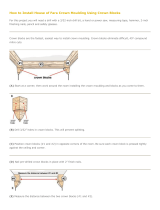
3
1. SAFETY AND LIABILITY
The decision has been made to install the cabinets and accessories yourself. This installation
guide is meant to assist you in the general installation process. The installation of cabinetry can
be a challenging task and we do recommend that you use a qualied cabinet installer. However
you may have the skill-set to complete the installation on your own. HUGO&BORG has no control over
the installation, so you are responsible and liable for completing the installation correctly and safely.
SAFETY AND LIABILITY DISCLAIMER:
Please note that the following instructions are only a guide to cabinet installation.
HUGO&BORG will not be liable for any damage to cabinets, cabinet hardware, ooring,
walls, etc., due to improper installation or mishandling of cabinets.
To reduce the risk of serious or fatal injury, read and understand this installation guide
before commencing with the installation.
This HUGO&BORG installation guide is not intended to cover every possible contingency
that might be encountered during installation or to endorse the use of any particular tool.
HUGO&BORG hereby expressly disclaims all warranties and all liability for any claims
for injury or death related to or based upon the use of this installation guide.
A qualied service professional should be used for any electrical or gas line work.
All gas, electrical and water connections must be shut off in any work area.
ITEMS THAT YOU SHOULD CONSIDER:
Do you have experience with carpentry and cutting miters?
Required tools: for a quality installation you will require several tools. They can be
expensive and require experience to operate in a safe and efcient manner.
Condition of the site: oors are level, and walls are square and level.
Basic plumbing and electrical skills may also be required.
It is recommended that there are two people to install the cabinets.
2. TOOLS AND SUPPLIES
The following may or may not be required depending on the complexity of your installation:
• UL approved safety goggles, steel-toe shoes and earplugs.
• Table saw, miter saw and jig saw.
• Drill and bits, compressor, pin nailer and nails.
• Clamps, levels, squares, straight edge and line levels.
• Extension cord, lighting and ladders.
• Stud nder, handle jig and circuit tester.
• Tape measure, screwdrivers, hammer pencil and masking tape.
• Installation wood screws (1 1/8" and 2 1/2") and screw caps (for wood stud construction).
• Carpenter glue.












